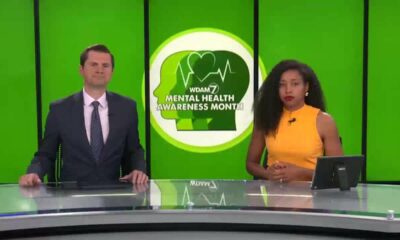Kaiser Health News
Early Detection May Help Kentucky Tamp Down Its Lung Cancer Crisis
Charlotte Huff
Thu, 15 Feb 2024 10:00:00 +0000
Anthony Stumbo's heart sank after the doctor shared his mother's chest X-ray.
“I remember that drive home, bringing her back home, and we basically cried,” said the internal medicine physician, who had started practicing in eastern Kentucky near his childhood home shortly before his mother began feeling ill. “Nobody wants to get told they've got inoperable lung cancer. I cried because I knew what this meant for her.”
Now Stumbo, whose mother died the following year, in 1997, is among a group of Kentucky clinicians and researchers determined to rewrite the script for other families by promoting training and boosting awareness about early detection in the state with the highest lung cancer death rate. For the past decade, Kentucky researchers have promoted lung cancer screening, first recommended by the U.S. Preventive Services Task Force in 2013. These days the Bluegrass State screens more residents who are at high risk of developing lung cancer than any state except Massachusetts — 10.6% of eligible residents in 2022, more than double the national rate of 4.5% — according to the most recent American Lung Association analysis.
The effort has been driven by a research initiative called the Kentucky LEADS (Lung Cancer Education, Awareness, Detection, and Survivorship) Collaborative, which in 2014 launched to improve screening and prevention, to identify more tumors earlier, when survival odds are far better. The group has worked with clinicians and hospital administrators statewide to boost screening rates both in urban areas and regions far removed from academic medical centers, such as rural Appalachia. But, a decade into the program, the researchers face an ongoing challenge as they encourage more people to get tested, namely the fear and stigma that swirl around smoking and lung cancer.
Lung cancer kills more Americans than any other malignancy, and the death rates are worst in a swath of states including Kentucky and its neighbors Tennessee and West Virginia, and stretching south to Mississippi and Louisiana, according to data from the Centers for Disease Control and Prevention.
It's a bit early to see the impact on lung cancer deaths because people may still live for years with a malignancy, LEADS researchers said. Plus, treatment improvements and other factors may also help reduce death rates along with increased screening. Still, data already shows that more cancers in Kentucky are being detected before they become advanced, and thus more difficult to treat, they said. Of total lung cancer cases statewide, the percentage of advanced cases — defined as cancers that had spread to the lymph nodes or beyond — hovered near 81% between 2000 and 2014, according to Kentucky Cancer Registry data. By 2020, that number had declined to 72%, according to the most recent data available.
“We are changing the story of families. And there is hope where there has not been hope before,” said Jennifer Knight, a LEADS principal investigator.
Older adults in their 60s and 70s can hold a particularly bleak view of their mortality odds, given what their loved ones experienced before screening became available, said Ashley Shemwell, a nurse navigator for the lung cancer screening program at Owensboro Health, a nonprofit health system that serves Kentucky and Indiana.
“A lot of them will say, ‘It doesn't matter if I get lung cancer or not because it's going to kill me. So I don't want to know,'” said Shemwell. “With that generation, they saw a lot of lung cancers and a lot of deaths. And it was terrible deaths because they were stage 4 lung cancers.” But she reminds them that lung cancer is much more treatable if caught before it spreads.
The collaborative works with several partners, including the University of Kentucky, the University of Louisville, and GO2 for Lung Cancer, and has received grant funding from the Bristol Myers Squibb Foundation. Leaders have provided training and other support to 10 hospital-based screening programs, including a stipend to pay for resources such as educational materials or a nurse navigator, Knight said. In 2022, state lawmakers established a statewide lung cancer screening program based in part on the group's work.
Jacob Sands, a lung cancer physician at Boston's Dana-Farber Cancer Institute, credits the LEADS collaborative with encouraging patients to return for annual screening and follow-up testing for any suspicious nodules. “What the Kentucky LEADS program is doing is fantastic, and that is how you really move the needle in implementing lung screening on a larger scale,” said Sands, who isn't affiliated with the Kentucky program and serves as a volunteer spokesperson for the American Lung Association.
In 2014, Kentucky expanded Medicaid, increasing the number of lower-income people who qualified for lung cancer screening and any related treatment. Adults 50 to 80 years old are advised to get a CT scan every year if they have accumulated at least 20 pack years and still smoke or have quit within the past 15 years, according to the latest task force recommendation, which widened the pool of eligible adults. (To calculate pack years, multiply the packs of cigarettes smoked daily by years of smoking.) The lung association offers an online quiz, called “Saved By The Scan,” to figure out likely eligibility for insurance coverage.
Half of U.S. patients aren't diagnosed until their cancer has spread beyond the lungs and lymph nodes to elsewhere in the body. By then, the five-year survival rate is 8.2%.
But regular screening boosts those odds. When a CT scan detects lung cancer early, patients have an 81% chance of living at least 20 years, according to data published in November in the journal Radiology.
Some adults, like Lisa Ayers, didn't realize lung cancer screening was an option. Her family doctor recommended a CT scan last year after she reported breathing difficulties. Ayers, who lives in Ohio near the Kentucky border, got screened at UK King's Daughters, a hospital in far eastern Kentucky. The scan didn't take much time, and she didn't have to undress, the 57-year-old said. “It took me longer to park,” she quipped.
She was diagnosed with a lung carcinoid tumor, a type of neuroendocrine cancer that can grow in various parts of the body. Her cancer was considered too risky for surgery, Ayers said. A biopsy showed the cancer was slow-growing, and her doctors said they would monitor it closely.
Ayers, a lifelong smoker, recalled her doctor said that her type of cancer isn't typically linked to smoking. But she quit anyway, feeling like she'd been given a second chance to avoid developing a smoking-related cancer. “It was a big wake-up call for me.”
Adults with a smoking history often report being treated poorly by medical professionals, said Jamie Studts, a health psychologist and a LEADS principal investigator, who has been involved with the research from the start. The goal is to avoid stigmatizing people and instead to build rapport, meeting them where they are that day, he said.
“If someone tells us that they're not ready to quit smoking but they want to have lung cancer screening, awesome; we'd love to help,” Studts said. “You know what? You actually develop a relationship with an individual by accepting, ‘No.'”
Nationally, screening rates vary widely. Massachusetts reaches 11.9% of eligible residents, while California ranks last, screening just 0.7%, according to the lung association analysis.
That data likely doesn't capture all California screenings, as it may not include CT scans done through large managed care organizations, said Raquel Arias, a Los Angeles-based associate director of state partnerships at the American Cancer Society. She cited other 2022 data for California, looking at lung cancer screening for eligible Medicare fee-for-service patients, which found a screening rate of 1%-2% in that population.
But, Arias said, the state's effort is “nowhere near what it needs to be.”
The low smoking rate in California, along with its image as a healthy state, “seems to have come with the unintended consequence of further stigmatizing people who smoke,” said Arias, citing one of the findings from a 2022 report looking at lung cancer screening barriers. For instance, eligible patients may be reluctant to share prior smoking habits with their health provider, she said.
Meanwhile, Kentucky screening efforts progress, scan by scan.
At Appalachian Regional Healthcare, 3,071 patients were screened in 2023, compared with 372 in 2017. “We're just scratching the surface of the potential lives that we can have an effect on,” said Stumbo, a lung cancer screening champion at the health system, which includes 14 hospitals, most located in eastern Kentucky.
The doctor hasn't shed his own grief about what his family missed after his mother died at age 51, long before annual screening was recommended. “Knowing that my children were born, and never knowing their grandmother,” he said, “just how sad is that?”
KFF Health News is a national newsroom that produces in-depth journalism about health issues and is one of the core operating programs at KFF—an independent source of health policy research, polling, and journalism. Learn more about KFF.
USE OUR CONTENT
This story can be republished for free (details).
——————————
By: Charlotte Huff
Title: Early Detection May Help Kentucky Tamp Down Its Lung Cancer Crisis
Sourced From: kffhealthnews.org/news/article/lung-cancer-kentucky-early-detection-success-survival/
Published Date: Thu, 15 Feb 2024 10:00:00 +0000
Did you miss our previous article…
https://www.biloxinewsevents.com/new-eligibility-rules-are-a-financial-salve-for-nearly-2-million-on-medi-cal/
Kaiser Health News
KFF Health News’ ‘What the Health?’: Bird Flu Lands as the Next Public Health Challenge
Thu, 16 May 2024 18:30:00 +0000
The Host
Julie Rovner
KFF Health News
Julie Rovner is chief Washington correspondent and host of KFF Health News' weekly health policy news podcast, “What the Health?” A noted expert on health policy issues, Julie is the author of the critically praised reference book “Health Care Politics and Policy A to Z,” now in its third edition.
Public health officials are watching with concern since a strain of bird flu spread to dairy cows in at least nine states, and to at least one dairy worker. But in the wake of covid-19, many farmers are loath to let in health authorities for testing.
Meanwhile, another large health company — the Catholic hospital chain Ascension — has been targeted by a cyberattack, leading to serious problems at some facilities.
This week's panelists are Julie Rovner of KFF Health News, Rachel Cohrs Zhang of Stat, Alice Miranda Ollstein of Politico, and Sandhya Raman of CQ Roll Call.
Panelists
Rachel Cohrs Zhang
Stat News
Alice Miranda Ollstein
Politico
Sandhya Raman
CQ Roll Call
Among the takeaways from this week's episode:
- Stumbles in the early response to bird flu bear an uncomfortable resemblance to the early days of covid, including the troubles protecting workers who could be exposed to the disease. Notably, the Department of Agriculture benefited from millions in covid relief funds designed to strengthen disease surveillance.
- Congress is working to extend coverage of telehealth care; the question is, how to pay for it? Lawmakers appear to have settled on a two-year agreement, though more on the extension — including how much it will cost — remains unknown.
- Speaking of telehealth, a new report shows about 20% of medication abortions are supervised via telehealth care. State-level restrictions are forcing those in need of abortion care to turn to options farther from home.
- And new reporting on Medicaid illuminates the number of people falling through the cracks of the government health system for low-income and disabled Americans — including how insurance companies benefit from individuals' confusion over whether they have Medicaid coverage at all.
Also this week, Rovner interviews Atul Grover of the Association of American Medical Colleges about its recent analysis showing that graduating medical students are avoiding training in states with abortion bans and major restrictions.
Plus, for “extra credit,” the panelists suggest health policy stories they read this week that they think you should read, too:
Julie Rovner: NPR's “Why Writing by Hand Beats Typing for Thinking and Learning,” by Jonathan Lambert.
Alice Miranda Ollstein: Time's “‘I Don't Have Faith in Doctors Anymore.' Women Say They Were Pressured Into Long-Term Birth Control,” by Alana Semuels.
Rachel Cohrs Zhang: Stat's “After Decades Fighting Big Tobacco, Cliff Douglas Now Leads a Foundation Funded by His Former Adversaries,” by Nicholas Florko.
Sandhya Raman: The Baltimore Banner's “People With Severe Mental Illness Are Stuck in Jail. Montgomery County Is the Epicenter of the Problem,” by Ben Conarck.
Also mentioned on this week's podcast:
- Stat's “My Rendezvous With the Raw Milk Black Market: Quick, Easy, and Unchecked by the FDA,” by Nicholas Florko.
- The Stamford Advocate's “Dan Haar: Hackers Stole a Disabled CT Couple's SNAP Food Aid. Now They're Out $1,373,” by Dan Haar.
- WKRN's “‘Chaos': Nurses, Visitors Describe Conditions Inside Ascension Hospitals After Cyberattack,” by Stephanie Langston.
- KFF Health News' “Medicaid ‘Unwinding' Decried as Biased Against Disabled People,” by Daniel Chang.
- KFF Health News' “Why Medicaid's ‘Undercount' Problem Counts,” by Phil Galewitz.
Credits
Francis Ying
Audio producer
Emmarie Huetteman
Editor
To hear all our podcasts, click here.
And subscribe to KFF Health News' “What the Health?” on Spotify, Apple Podcasts, Pocket Casts, or wherever you listen to podcasts.
——————————
Title: KFF Health News' ‘What the Health?': Bird Flu Lands as the Next Public Health Challenge
Sourced From: kffhealthnews.org/news/podcast/what-the-health-347-bird-flu-next-public-health-challenge-may-16-2024/
Published Date: Thu, 16 May 2024 18:30:00 +0000
Kaiser Health News
California’s $12 Billion Medicaid Makeover Banks on Nonprofits’ Buy-In
Angela Hart
Thu, 16 May 2024 09:00:00 +0000
TURLOCK, Calif. — For much of his young life, Jorge Sanchez regularly gasped for air, at times coughing so violently that he'd almost throw up. His mother whisked him to the emergency room late at night and slept with him to make sure he didn't stop breathing.
“He's had these problems since he was born, and I couldn't figure out what was triggering his asthma,” Fabiola Sandoval said of her son, Jorge, now 4. “It's so hard when your child is hurting. I was willing to try anything.”
In January, community health workers visited Sandoval's home in Turlock, a city in California's Central Valley where dust from fruit and nut orchards billows through the air. They scoured Sandoval's home for hazards and explained that harsh cleaning products, air fresheners, and airborne dust and pesticides can trigger an asthma attack.
The team also provided Sandoval with air purifiers, a special vacuum cleaner that can suck dust out of the air, hypoallergenic mattress covers, and a humidity sensor — goods that retail for hundreds of dollars. Within a few months, Jorge was breathing easier and was able to run and play outside.
The in-home consultation and supplies were paid for by Medi-Cal, California's Medicaid health insurance program for low-income residents. Gov. Gavin Newsom is spearheading an ambitious $12 billion experiment to transform Medi-Cal into both a health insurer and a social services provider, one that relies not only on doctors and nurses, but also community health workers and nonprofit groups that offer dozens of services, including delivering healthy meals and helping homeless people pay for housing.
These groups are redefining health care in California as they compete with businesses for a share of the money, and become a new arm of the sprawling Medi-Cal bureaucracy that serves nearly 15 million low-income residents on an annual budget of $158 billion.
But worker shortages, negotiations with health insurance companies, and learning to navigate complex billing and technology systems have hamstrung the community groups' ability to deliver the new services: Now into the third year of the ambitious five-year experiment, only a small fraction of eligible patients have received benefits.
“This is still so new, and everyone is just overwhelmed at this point, so it's slow-going,” said Kevin Hamilton, a senior director at the Central California Asthma Collaborative.
The collaborative has served about 3,650 patients, including Sandoval, in eight counties since early 2022, he said. It has years of experience with Medi-Cal patients in the Central Valley and has received about $1.5 million of the new initiative's money.
By contrast, CalOptima Health, Orange County's primary Medi-Cal insurer, is new to offering asthma benefits and has signed up 58 patients so far.
“Asthma services are so difficult to get going” because the nonprofit infrastructure for these services is virtually nonexistent, said Kelly Bruno-Nelson, CalOptima's executive director for Medi-Cal. “We need more community-based organizations on board because they're the ones who can serve a population that nobody wants to deal with.”
Newsom, a Democrat in his second term, says his signature health care initiative, known as CalAIM, seeks to reduce the cost of caring for the state's sickest and most vulnerable patients, including homeless Californians, foster children, former inmates, and people battling addiction disorders.
In addition to in-home asthma remediation, CalAIM offers 13 broad categories of social services, plus a benefit connecting eligible patients with one-on-one care managers to help them obtain anything they need to get healthier, from grocery shopping to finding a job.
The 25 managed-care insurance companies participating in Medi-Cal can choose which services they offer, and contract with community groups to provide them. Insurers have hammered out about 4,300 large and small contracts with nonprofits and businesses.
So far, about 103,000 Medi-Cal patients have received CalAIM services and roughly 160,000 have been assigned personal care managers, according to state data, a sliver of the hundreds of thousands of patients who likely qualify.
“We're all new to health care, and a lot of this is such a foreign concept,” said Helena Lopez, executive director of A Greater Hope, a nonprofit organization providing social services in Riverside and San Bernardino counties, such as handing out baseball cleats to children to help them be active.
Tiffany Sickler runs Koinonia Family Services, which offers California foster children mental health and other types of care, and even helped a patient pay off parking tickets. But the program is struggling on a shoestring budget.
“If you want to do this, you have to learn all these new systems. It's been a huge learning curve, and very time-consuming and frustrating, especially without adequate funding,” she said.
Brandon Richards, a Newsom spokesperson, defended CalAIM, saying that it was “on the cutting edge of health care” and that the state was working to increase “awareness of these new services and support.”
For nonprofits and businesses, CalAIM is a money-making opportunity — one that top state health officials hope to make permanent. Health insurers, which receive hefty payments from the state to serve more people and offer new services, share a portion with service providers.
In some places, community groups are competing with national corporations for the new funding, such as Mom's Meals, an Iowa-based company that delivers prepared meals across the United States.
Mom's Meals has an advantage over neighborhood nonprofit groups because it has long served seniors on Medicare and was able to immediately start offering the CalAIM benefit of home-delivered meals for patients with chronic diseases. But even Mom's Meals isn't reaching everyone who qualifies, because doctors and patients don't always know it's an option, said Catherine Macpherson, the company's chief nutrition officer.
“Utilization is not as high as it should be yet,” she said. “But we were well positioned, because we already had departments to do billing and contracting with health care.”
Middleman companies also have their eye on the billions of CalAIM dollars and are popping up to assist small organizations to go up against established ones like Mom's Meals. For instance, the New York-based Nonprofit Finance Fund is advising homeless service providers how to get more contracts and expand benefits.
Full Circle Health Network, with 70 member organizations, is helping smaller nonprofit groups develop and deliver services primarily for families and foster children. Full Circle has signed a deal with Kaiser Permanente, allowing the health care giant to access its network of community groups.
“We're allowing organizations to launch these benefits much faster than they've been able to do and to reach more vulnerable people,” said Camille Schraeder, chief executive of Full Circle. “Many of these are grassroots organizations that have the trust and expertise on the ground, but they're new to health care.”
One of the biggest challenges community groups face is hiring workers, who are key to finding eligible patients and persuading them to participate.
Kathryn Phillips, a workforce expert at the California Health Care Foundation, said there isn't enough seed money for community groups to hire workers and pay for new technology platforms. “They bring the trust that is needed, the cultural competency, the diversity of languages,” she said. “But there needs to be more funding and reimbursement to build this workforce.”
Health insurers say they are trying to increase the workforce. For instance, L.A. Care Health Plan, the largest Medi-Cal insurer in California, has given $66 million to community organizations for hiring and other CalAIM needs, said Sameer Amin, the group's chief medical officer.
“They don't have the staffing to do all this stuff, so we're helping with that all while teaching them how to build up their health care infrastructure,” he said. “Everyone wants a win, but this isn't going to be successful overnight.”
In the Central Valley, Jorge Sanchez is one of the lucky early beneficiaries of CalAIM.
His mother credits the trust she established with community health workers, who spent many hours over multiple visits to teach her how to control her son's asthma.
“I used to love cleaning with bleach” but learned it can trigger breathing problems, Sandoval said.
Since she implemented the health workers' recommendations, Sandoval has been able to let Jorge sleep alone at night for the first time in four years.
“Having this program and all the things available is amazing,” said Sandoval, as she pointed to the dirty dust cup in her new vacuum cleaner. “Now my son doesn't have as many asthma attacks and he can run around and be a normal kid.”
This article was produced by KFF Health News, which publishes California Healthline, an editorially independent service of the California Health Care Foundation.
——————————
By: Angela Hart
Title: California's $12 Billion Medicaid Makeover Banks on Nonprofits' Buy-In
Sourced From: kffhealthnews.org/news/article/newsom-medicaid-12-billion-dollar-makeover-nonprofits-bureacracy-calaim/
Published Date: Thu, 16 May 2024 09:00:00 +0000
Kaiser Health News
Federal Panel Prescribes New Mental Health Strategy To Curb Maternal Deaths
Cheryl Platzman Weinstock
Thu, 16 May 2024 09:00:00 +0000
For help, call or text the National Maternal Mental Health Hotline at 1-833-TLC-MAMA (1-833-852-6262) or contact the 988 Suicide & Crisis Lifeline by dialing or texting “988.” Spanish-language services are also available.
BRIDGEPORT, Conn. — Milagros Aquino was trying to find a new place to live and had been struggling to get used to new foods after she moved to Bridgeport from Peru with her husband and young son in 2023.
When Aquino, now 31, got pregnant in May 2023, “instantly everything got so much worse than before,” she said. “I was so sad and lying in bed all day. I was really lost and just surviving.”
Aquino has lots of company.
Perinatal depression affects as many as 20% of women in the United States during pregnancy, the postpartum period, or both, according to studies. In some states, anxiety or depression afflicts nearly a quarter of new mothers or pregnant women.
Many women in the U.S. go untreated because there is no widely deployed system to screen for mental illness in mothers, despite widespread recommendations to do so. Experts say the lack of screening has driven higher rates of mental illness, suicide, and drug overdoses that are now the leading causes of death in the first year after a woman gives birth.
“This is a systemic issue, a medical issue, and a human rights issue,” said Lindsay R. Standeven, a perinatal psychiatrist and the clinical and education director of the Johns Hopkins Reproductive Mental Health Center.
Standeven said the root causes of the problem include racial and socioeconomic disparities in maternal care and a lack of support systems for new mothers. She also pointed a finger at a shortage of mental health professionals, insufficient maternal mental health training for providers, and insufficient reimbursement for mental health services. Finally, Standeven said, the problem is exacerbated by the absence of national maternity leave policies, and the access to weapons.
Those factors helped drive a 105% increase in postpartum depression from 2010 to 2021, according to the American Journal of Obstetrics & Gynecology.
For Aquino, it wasn't until the last weeks of her pregnancy, when she signed up for acupuncture to relieve her stress, that a social worker helped her get care through the Emme Coalition, which connects girls and women with financial help, mental health counseling services, and other resources.
Mothers diagnosed with perinatal depression or anxiety during or after pregnancy are at about three times the risk of suicidal behavior and six times the risk of suicide compared with mothers without a mood disorder, according to recent U.S. and international studies in JAMA Network Open and The BMJ.
The toll of the maternal mental health crisis is particularly acute in rural communities that have become maternity care deserts, as small hospitals close their labor and delivery units because of plummeting birth rates, or because of financial or staffing issues.
This week, the Maternal Mental Health Task Force — co-led by the Office on Women's Health and the Substance Abuse and Mental Health Services Administration and formed in September to respond to the problem — recommended creating maternity care centers that could serve as hubs of integrated care and birthing facilities by building upon the services and personnel already in communities.
The task force will soon determine what portions of the plan will require congressional action and funding to implement and what will be “low-hanging fruit,” said Joy Burkhard, a member of the task force and the executive director of the nonprofit Policy Center for Maternal Mental Health.
Burkhard said equitable access to care is essential. The task force recommended that federal officials identify areas where maternity centers should be placed based on data identifying the underserved. “Rural America,” she said, “is first and foremost.”
There are shortages of care in “unlikely areas,” including Los Angeles County, where some maternity wards have recently closed, said Burkhard. Urban areas that are underserved would also be eligible to get the new centers.
“All that mothers are asking for is maternity care that makes sense. Right now, none of that exists,” she said.
Several pilot programs are designed to help struggling mothers by training and equipping midwives and doulas, people who provide guidance and support to the mothers of newborns.
In Montana, rates of maternal depression before, during, and after pregnancy are higher than the national average. From 2017 to 2020, approximately 15% of mothers experienced postpartum depression and 27% experienced perinatal depression, according to the Montana Pregnancy Risk Assessment Monitoring System. The state had the sixth-highest maternal mortality rate in the country in 2019, when it received a federal grant to begin training doulas.
To date, the program has trained 108 doulas, many of whom are Native American. Native Americans make up 6.6% of Montana's population. Indigenous people, particularly those in rural areas, have twice the national rate of severe maternal morbidity and mortality compared with white women, according to a study in Obstetrics and Gynecology.
Stephanie Fitch, grant manager at Montana Obstetrics & Maternal Support at Billings Clinic, said training doulas “has the potential to counter systemic barriers that disproportionately impact our tribal communities and improve overall community health.”
Twelve states and Washington, D.C., have Medicaid coverage for doula care, according to the National Health Law Program. They are California, Florida, Maryland, Massachusetts, Michigan, Minnesota, Nevada, New Jersey, Oklahoma, Oregon, Rhode Island, and Virginia. Medicaid pays for about 41% of births in the U.S., according to the Centers for Disease Control and Prevention.
Jacqueline Carrizo, a doula assigned to Aquino through the Emme Coalition, played an important role in Aquino's recovery. Aquino said she couldn't have imagined going through such a “dark time alone.” With Carrizo's support, “I could make it,” she said.
Genetic and environmental factors, or a past mental health disorder, can increase the risk of depression or anxiety during pregnancy. But mood disorders can happen to anyone.
Teresa Martinez, 30, of Price, Utah, had struggled with anxiety and infertility for years before she conceived her first child. The joy and relief of giving birth to her son in 2012 were short-lived.
Without warning, “a dark cloud came over me,” she said.
Martinez was afraid to tell her husband. “As a woman, you feel so much pressure and you don't want that stigma of not being a good mom,” she said.
In recent years, programs around the country have started to help doctors recognize mothers' mood disorders and learn how to help them before any harm is done.
One of the most successful is the Massachusetts Child Psychiatry Access Program for Moms, which began a decade ago and has since spread to 29 states. The program, supported by federal and state funding, provides tools and training for physicians and other providers to screen and identify disorders, triage patients, and offer treatment options.
But the expansion of maternal mental health programs is taking place amid sparse resources in much of rural America. Many programs across the country have run out of money.
The federal task force proposed that Congress fund and create consultation programs similar to the one in Massachusetts, but not to replace the ones already in place, said Burkhard.
In April, Missouri became the latest state to adopt the Massachusetts model. Women on Medicaid in Missouri are 10 times as likely to die within one year of pregnancy as those with private insurance. From 2018 through 2020, an average of 70 Missouri women died each year while pregnant or within one year of giving birth, according to state government statistics.
Wendy Ell, executive director of the Maternal Health Access Project in Missouri, called her service a “lifesaving resource” that is free and easy to access for any health care provider in the state who sees patients in the perinatal period.
About 50 health care providers have signed up for Ell's program since it began. Within 30 minutes of a request, the providers can consult over the phone with one of three perinatal psychiatrists. But while the doctors can get help from the psychiatrists, mental health resources for patients are not as readily available.
The task force called for federal funding to train more mental health providers and place them in high-need areas like Missouri. The task force also recommended training and certifying a more diverse workforce of community mental health workers, patient navigators, doulas, and peer support specialists in areas where they are most needed.
A new voluntary curriculum in reproductive psychiatry is designed to help psychiatry residents, fellows, and mental health practitioners who may have little or no training or education about the management of psychiatric illness in the perinatal period. A small study found that the curriculum significantly improved psychiatrists' ability to treat perinatal women with mental illness, said Standeven, who contributed to the training program and is one of the study's authors.
Nancy Byatt, a perinatal psychiatrist at the University of Massachusetts Chan School of Medicine who led the launch of the Massachusetts Child Psychiatry Access Program for Moms in 2014, said there is still a lot of work to do.
“I think that the most important thing is that we have made a lot of progress and, in that sense, I am kind of hopeful,” Byatt said.
Cheryl Platzman Weinstock's reporting is supported by a grant from the National Institute for Health Care Management Foundation.
——————————
By: Cheryl Platzman Weinstock
Title: Federal Panel Prescribes New Mental Health Strategy To Curb Maternal Deaths
Sourced From: kffhealthnews.org/news/article/postpartum-mental-health-federal-strategy-maternal-deaths/
Published Date: Thu, 16 May 2024 09:00:00 +0000
Did you miss our previous article…
https://www.biloxinewsevents.com/medics-at-ucla-protest-say-police-weapons-drew-blood-and-cracked-bones/
-
SuperTalk FM4 days ago
Martin Lawrence making 3 stops in Mississippi on comedy tour
-
Our Mississippi Home3 days ago
Beat the Heat with Mississippi’s Best Waterparks
-
Mississippi Today7 days ago
Lawmakers may have to return to Capitol May 14 to override Gov. Tate Reeves’ potential vetoes
-
Our Mississippi Home4 days ago
Charlie’s U-Pik: Opening Soon for the Summer Season
-
Mississippi News Video6 days ago
Local dentists offer free dental care in Amory
-
Kaiser Health News3 days ago
Medicaid ‘Unwinding’ Decried as Biased Against Disabled People
-
Mississippi News Video2 days ago
Jackson has a gang problem
-
Mississippi News6 days ago
Bond set for West Point couple accused of killing their child



























![HIGH SCHOOL SOFTBALL: Vancleave @ East Central (5/9/2024) [5A Playoffs, South State]](https://www.biloxinewsevents.com/wp-content/uploads/2024/05/1715460379_maxresdefault-80x80.jpg)







